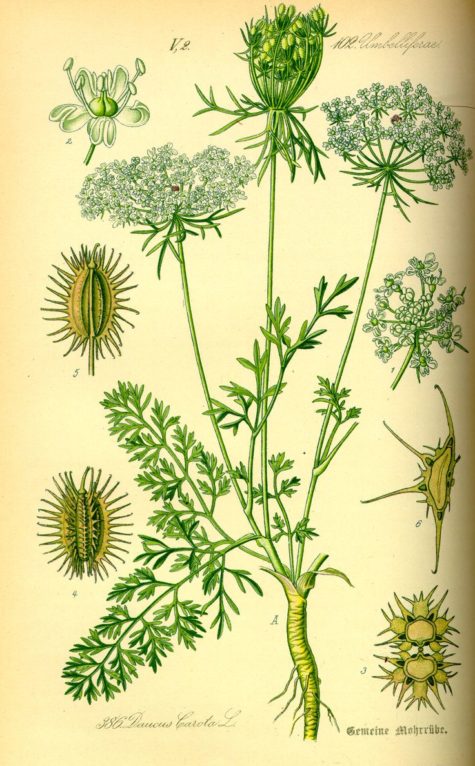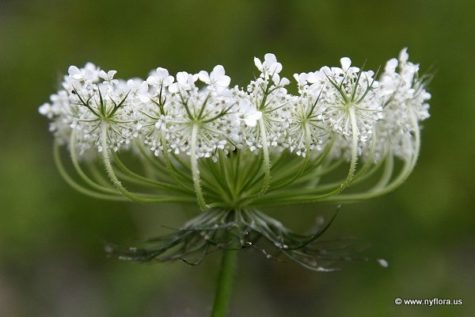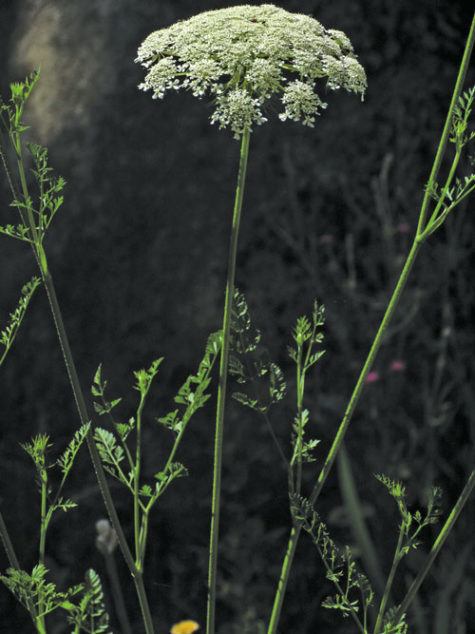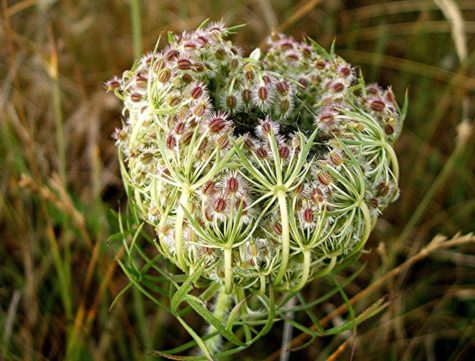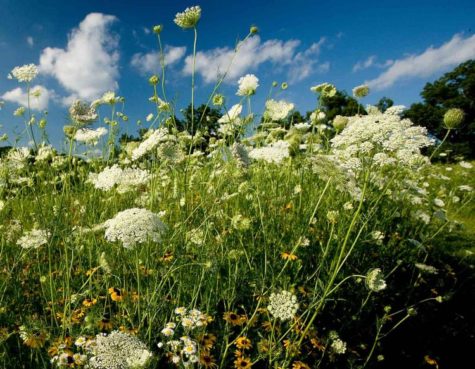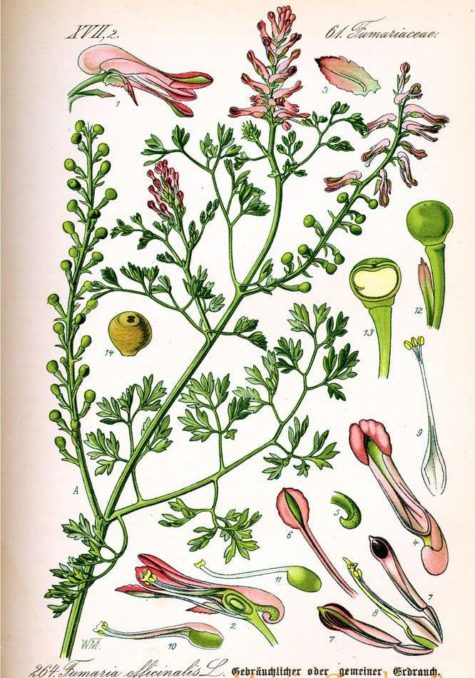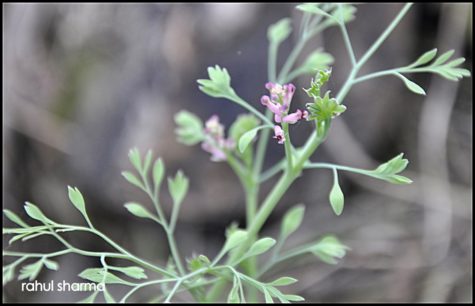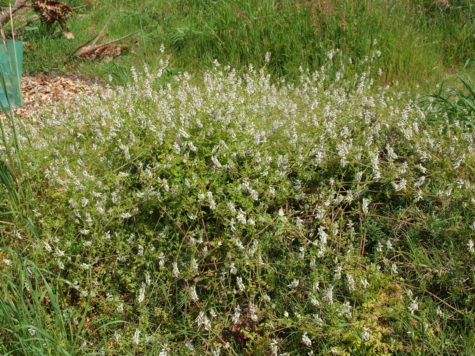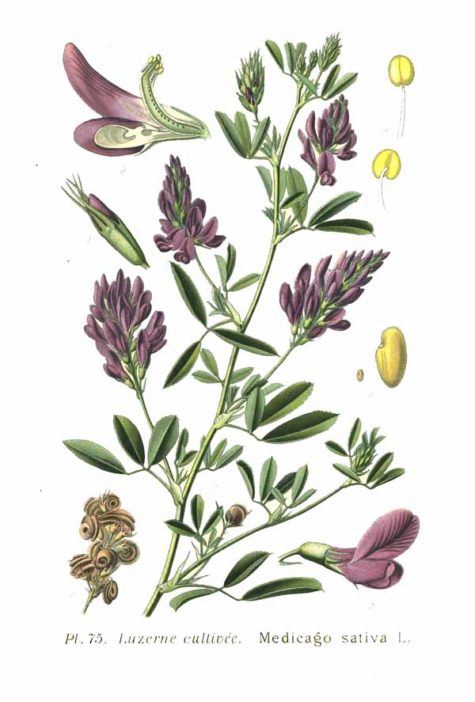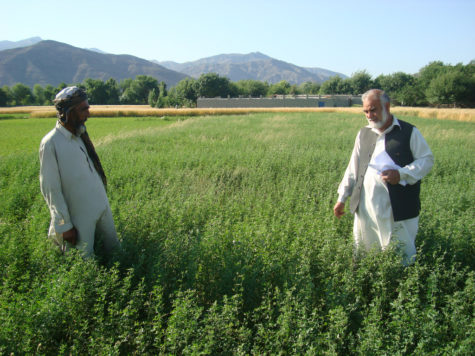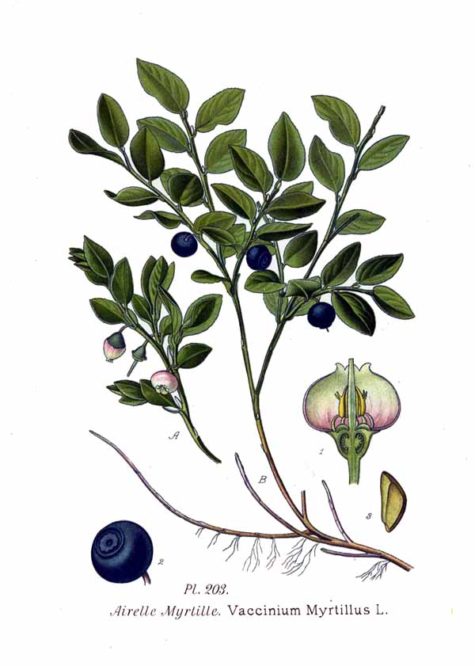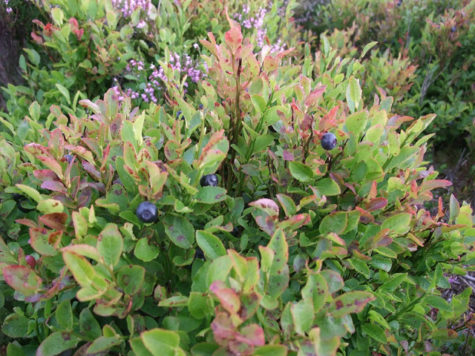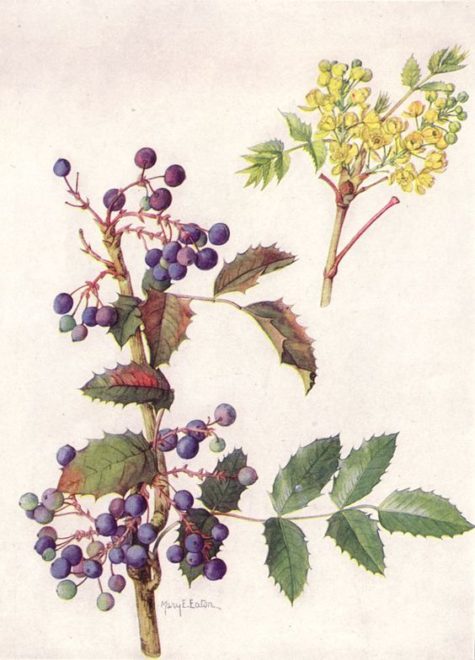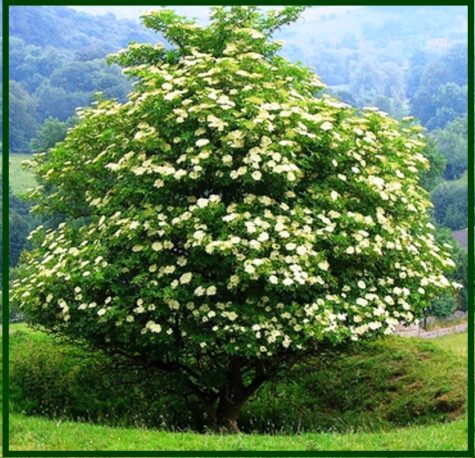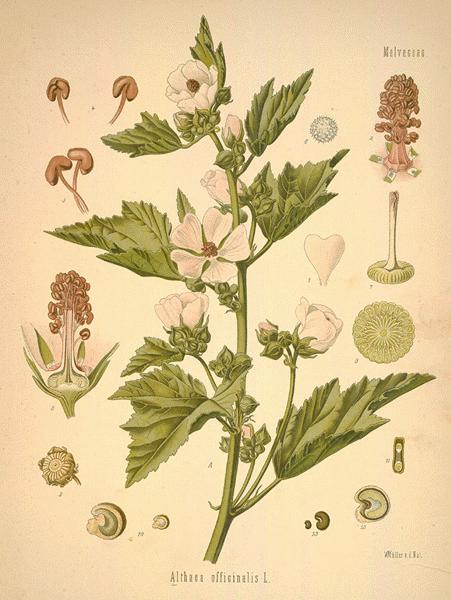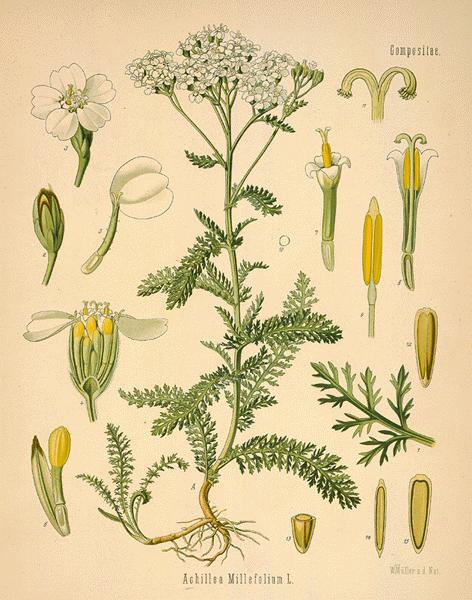Diuretic
Wild Carrot
- Scientific name: Daucus carota
- Common name: Queen Anne’s Lace
- Plant family: Apiaceae
- Parts used: Whole herb, seeds, root
- Medicinal actions: Diuretic, Anti-lithic, Carminative, Abortifacient, Deobstruent, Emmenagogue
- How does it work? Wild Carrot contains chemicals that might have effects on blood vessels, muscles, and the heart.
General Overview
Wild Carrot, or Queen Anne’s Lace is the wild progenitor of our cultivated carrot. It still has many of the properties lost in cultivation. If an apple a day will keep the Doctor away, legend has it that a Wild Carrot a day might keep death itself away!
The parts that grow above the ground and an oil made from the seeds are used to make medicine. Be careful not to confuse Wild Carrot with the common carrot (which has the familiar orange tap root we eat).
Wild Carrot has been used for centuries as an alternative medicine. It is used for urinary tract problems including kidney stones, bladder problems, water retention, and excess uric acid in the urine; and also for gout, a painful joint problem caused by too much uric acid.
The seed oil is used for severe diarrhea (dysentery), indigestion, and intestinal gas. Women use it relieve pain in the uterus and to start their menstrual periods.
Other uses include treatment of heart disease, cancer, kidney problems, and worm infestations. It is also used as a “nerve tonic” and to increase sexual arousal (as an aphrodisiac).
Constituents
The medicinal properties of the seeds are owing to a volatile oil which is colorless or slightly tinged with yellow; this is procured by distilling with water. They also yield their virtues by infusion to water at 212° F; boiling dissipates them. No thorough analysis has been made.
Description
A pest to farmers, a joy to the flower-lover, and a welcome signal for refreshment to hosts of flies, beetles, bees, and wasps, especially to the paper-nest builders, the sprangly wild carrot lifts its fringy foliage and exquisite lacy blossoms above the dry soil of three continents. From Europe it has come to spread its delicate wheels over our summer landscape, until whole fields are whitened by them east of the Mississippi.
Wild carrot is a biennial plant, and in its second year, from a taproot, the stems grow to a height of two to four feet or more. The stems are erect and branched, generally about 2 feet high, tough and furrowed. Both stems and leaves are more or less clothed with stout coarse hairs. The leaves are very finely divided, the lowest leaves considerably larger than the upper; their arrangement on the stem is alternate, and all the leaves embrace the stem with the sheathing base, which is so characteristic of this group of plants, the Umbelliferae, to which the Carrot belongs.
The two to four inch “flower” is actually a compound of terminal umbels, made up of many small white flowers. The central flower of the Umbelliferae is often purple. A ring of finely-divided and leaf-like bracts grows at the point where the umbel meets the stem. The blossoms are densely clustered together in terminal umbels, or flattened heads, in which the flower-bearing stalks of the head all arise from one point in rays, like the ribs of an umbrella, each ray again dividing in the case of the Carrot, in like manner to form a secondary umbel, or umbellule of white flowers, the outer ones of which are irregular and larger than the others.
The Wild Carrot is in bloom from June to August, but often continues flowering much longer. The flowers themselves are very small, but from their whiteness and number, they form a conspicuous head nearly flat while in bloom, or slightly convex, but as the seeds ripen, the umbels contract, the outer rays, which are to begin with 1 to 2 inches long, lengthening and curving inwards, so that the head forms a hollow cup hence one of the old popular names for the plant – Birds’ Nest.
The fruit is slightly flattened, with numerous bristles arranged in five rows. The ring of finely-divided and leaf-like bracts at the point where the umbel springs is a noticeable feature.
Its root is small and spindle shaped, whitish, slender and hard, with a strong aromatic smell and an acrid, disagreeable taste, very different to the reddish, thick, fleshy, cultivated form, with its pleasant odor and peculiar, sweet, mucilaginous flavor. It penetrates some distance into the ground, having only a few lateral rootlets.
Varieties
The Carrot is well distinguished from other plants of the same order by having the central flower of the umbel, or sometimes a tiny umbellule, of a bright red or deep purple color, though there is a variety, Daucus maritimus, frequent in many parts of the seacoast in the south of England, which differs in having somewhat fleshy leaves and no central purple flower. In this case, all the flowers of the head have usually a somewhat pinkish tinge. There was a curious superstition that this small purple flower of the Carrot was of benefit for mitigating epilepsy.
Habitat
The Carrot was in ancient times much valued for its medicinal properties; the Wild Carrot, which is found so plentifully in Britain, both in cultivated lands and by waysides, thriving more especially by the sea, is superior, medicinally, to the cultivated kind.
Probably originally a native of the sea-coasts of Southern Europe degenerated into its present wild state, but of very ancient cultivation. The name ‘Carrot’ is Celtic, and means ‘red of colour,’ and Daucus from the Greek dais to burn, signifying its pungent and stimulating qualities.
This biennial herb has become naturalized throughout the United States and Canada. Wild Carrot blooms in summer and fall. It thrives best in sun to partial shade. Daucus carota is commonly found along roadsides and in unused fields.
Cautions
Extra caution should be used when collecting Wild Carrot because it bears a close resemblance to poison hemlock. In addition, the leaves of the Wild Carrot may cause phytophotodermatitis, so caution should also be used when handling the plant. It has been used as a method of contraception and an abortifacient for centuries. Continue reading
Fumitory
- Scientific name: Fumaria officinalis
- Family: Fumariaceae
- Medical Action: Laxative, alterative, cholagogue, hepatic, diuretic, and aperient, a weak tonic, slightly diaphoretic,
- Constituents: Alkaloids, bitter principle, mucilage, fumaric acid, amino acids, resin. The plant contains isoquinoline alkaloids protopine and allocryptopine.
- Parts Used: Leaves
- Other Fumitories: American Fumitory Fumaria Indica, or Codder Indian
The Basics
Earth smoke, as it is also called, is a wild poppy plant traditionally used as an incense herb with a stimulating effect on liver and gallbladder and as a protection against skin diseases and eczema. The drug fumitory is toxic in high doses.
Fumitory has been known since antiquity and was described in herbals from the Middle Ages. Fumitory is a predominantly Mediterranean genus that once was used medicinally. Traditional preparation involved expressing the juice and evaporating it. It has been used as a laxative and diuretic.
Fumaria species are used in Turkish folk medicine as a blood purifier and an anti-allergic agent.
In traditional medicine, the plant has been used to treat eczema and other dermatologic conditions. It was thought to be good for the eyes, and to remove skin blemishes. In modern times herbalists use it to treat skin diseases, and conjunctivitis; as well as to cleanse the kidneys.
Fumitory has a long history of use in the treatment of skin problems such as eczema and acne. Its action is probably due to a general cleansing mediated via the kidneys and liver. Fumitory may also be used as an eyewash to ease conjunctivitis.
The name is said to be derived either from the fact that its whitish, blue-green colour gives it the appearance of smoke rising from the ground, or, according to Pliny, because the juice of the plant brings on such a flow of tears that the sight becomes dim as with smoke, and hence its reputed use in affections of the eye.
Constituents
The leaves yield by expression a juice which has medicinal properties. An extract, prepared by evaporating the expressed juice, or a decoction of the leaves, throws out upon its surface a copious saline efflorescence. Fumaric acid was early identified as present, and its isomerism with maleic acid was established later.
The alkaloid Fumarine has been believed to be identical with corydaline, but it differs both in formula and in its reaction to sulphuric and nitric acids. It occurs in colourless, tasteless crystals, freely soluble in chloroform, less so in benzine, still less so in alcohol and ether, sparingly soluble in water.
Etymology
The “smoky” or “fumy” origin of its name comes from the translucent color of its flowers, giving them the appearance of smoke or of hanging in smoke, and the slightly gray-blue haze color of its foliage, also resembling smoke coming from the ground, especially after morning dew.
The plant was already called fūmus terrae (smoke of the earth) in the early 13th century, and two thousand years ago, Dioscorides wrote in De Materia Medica and Pliny the Elder in Naturalis Historia that rubbing the eyes with the sap or latex of the plant causes tears, like acrid smoke (fūmus) does to the eyes. Continue reading
Alfalfa
- Scientific Name: Medicago sativa
- Plant Family: Fabaceae
- Parts Used: The leaves, sprouts, and seeds.
- Actions: anti-anemic, appetizer, diuretic, galactagogue, laxative, nutrient, tonic.
- Qualities: Neutral thermal nature; Bitter flavor; Dries dampness, Spring, Yin
The basics:
Alfalfa follows the doctrine of signatures: its ability to produce exceptional roots benefits our “roots,” which are often identified physiologically as our intestines and kidney/bladder functions. Alfalfa cleans and tones the intestines and takes harmful acids out of the blood. It benefits the urinary system and intestines and detoxifies the body.
Alfalfa contains eight enzymes which help assimilate protein, fats, and carbohydrates. It is safe food even for children and helps nursing mothers produce more milk.
In ancient India, Ayurvedic texts prescribe the use of Alfalfa seeds and sprouts for improving blood cell production and its leaves and stem as a good source of protein and minerals.
Nutritional Value:
Alfalfa is rich in chlorophyll, carotene, protein, calcium and other minerals, vitamins in the B group, vitamin C, vitamin D, vitamin E, and vitamin K. Other important nutrients include iron, magnesium, potassium, phosphorus, sodium, sulfur, silicon, chlorine, cobalt, and zinc. Alfalfa also contains vitamins K and P, and abundant chlorophyll.
The sun-dried hay of alfalfa has been found to be a source of vitamin D, containing 48 ng/g (1920 IU/kg) vitamin D2 and 0.63 ng/g (25 IU/kg) vitamin D3. There is also reference to vitamin D2 and vitamin D3 being found in the alfalfa shoot.
Medicinal uses:
Alfalfa is used medicinally in a variety of ways, depending on the country, culture, and healing tradition.
- In China it is considered to have the following qualities: Anodyne, Depurative, Emetic and is used to treat Fever, Gravel, and Dysuria.
- In Iraq it is commonly used to treat Arthritis.
- In Turkey, in addition to treating Arthritis, it is considered to be a Cardiotonic and used to treat Scurvy.
- In the United States it is believed to be Cyanogenetic, and used in the treatment of and prevention of Cancer.
- Elsewhere it is used to treat Arthritis, Boils, as an Emmenagogue, Lactagogue, and for Scurvy.
Note: In this day and age of global information via the internet and social media, these dividing lines have become increasingly blurred.
Alfalfa is used for kidney conditions, bladder and prostate conditions, and to increase urine flow. It is also used for high cholesterol, asthma, osteoarthritis, rheumatoid arthritis, diabetes, upset stomach, and a bleeding disorder called thrombocytopenic purpura. People also take alfalfa as a source of vitamins A, C, E, and K4; and minerals calcium, potassium, phosphorous, and iron.
Other uses include edema, weight loss, bladder stones, plantar warts, chronic sore throat, fevers, gas pains, peptic ulcers, drug and alcohol addiction recovery.
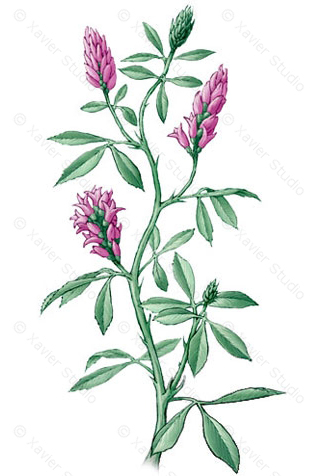 Alfalfa is helpful for chronic joint inflammation and aiding female hormonal balance. It comforts and strengthens the immune system. Alfalfa is rich in vitamins, minerals and other nutrients that play an important role in the maintenance of a healthy body. It contains protein, vitamin A, vitamin B1, vitamin B6, vitamin C, vitamin E, and vitamin K. It also contains calcium, potassium, carotene, iron and zinc and is considered one of the healthiest plant foods, providing an excellent range of nutritive properties for good health and well being.
Alfalfa is helpful for chronic joint inflammation and aiding female hormonal balance. It comforts and strengthens the immune system. Alfalfa is rich in vitamins, minerals and other nutrients that play an important role in the maintenance of a healthy body. It contains protein, vitamin A, vitamin B1, vitamin B6, vitamin C, vitamin E, and vitamin K. It also contains calcium, potassium, carotene, iron and zinc and is considered one of the healthiest plant foods, providing an excellent range of nutritive properties for good health and well being.
Interestingly, alfalfa is a treatment hay fever. Externally the seeds can be made into a poultice for boils, to soothe insect bites, and reduce inflammation. It alkalizes and detoxifies the body. Binds carcinogens in the colon to help speed up their elimination from the body.It is an overall tonic for general health, fatigue, weight gain, and debility. Alfalfa also stimulates the growth of supportive connective tissue, and is useful in the treatment of diabetes.
Alfalfa is a herb rich in protein and the vitamins A, D, E and K. The leaves contain eight of the essential amino acids.Such a a nutrient-rich formula, can be used to replenish the body with vitamins and minerals. It is specifically indicated for those with poor diets and inadequate nutrient intake.
Daily Dosages:
In addition to alfalfa sprouts found in most supermarkets, alfalfa is available as a dried leaf herb, in tablets, capsules, and powders.
- 2 to 3 cups tea
- 2 to 4 grams in capsules or pills 3 times a day
- 6 to 12 grams powder
- 3 ounces sprouts
To make tea, steep 1 tablespoon seed or 2 ounces dried leaf in 1 quart boiling water. In powder form, the pleasant taste of alfalfa is a welcome addition to soups and salads.
For high cholesterol: a typical dose is 5 to 10 grams of the herb, or as a steeped strained tea, three times a day. 5 to 10 mL of a liquid extract (1:1 in 25% alcohol) three times a day has also been used.
Herbal Combinations:
To get more natural vitamins, combine Alfafa with herbs such as Nettle and Rosehip, Nettle is high in both vitamin C and Iron, thus ensuring that energy levels and prevention of cellular damage is assisted. Nettles acts as a blood tonic with the ability to strengthen the body’s natural resistance. Rosehip is also extremely high in vitamin C and is one of the best herbs used for its antioxidant action on the body. It also assists with maintaining healthy collagen.
Cosmetic Uses:
Alfalfa extract (Medicago Sativum Extract) can be an antioxidant in skin-care products, it is said this extract is a great source of protein, minerals and vitamins C,D,E,K for the skin. Conditions and increases skin metabolism to promote skin healing,used as a topical skin conditioner.Alfalfa Extract is primarily used in manufacture of natural face masks and lotions. Saponins in alfalfa extract acts as natural foaming agent. Boots, Clarins and Lancome are using alfalfa extract in their skincare products. Continue reading
Bilberry
- Scientific Name: Vaccinium myrtillus
- Plant Family: N.O. Vacciniaceae
- Parts Used: The ripe fruit. The leaves.
- Actions: astringent, diuretic, tonic, antiseptic,antibacterial
Varieties:
- V. arboreum, or Farkleberry. This is the most astringent variety, and both berries and root-bark may be used internally for diarrhoea, chronic dysentery, etc. The infusion is valuable as a local application in sore throat, chronic ophthalmia, leucorrhoea, etc.
- V. resinosum, V. damusum, and V. gorymbosum have properties resembling those of V. myrtillus.
- The Bog Bilberry ( V. uliginosum) is a smaller, less erect plant, with round stems and untoothed leaves, greyish green beneath. Both flowers and berries are smaller than those of the common Bilberry. This kind is quite absent in the south and only to be found in mountain bogs and moist copses, in Scotland, Durham and Westmorland.
- The ‘Huckleberry’ of North America, so widely appreciated there, is our Bilberry – the name being an obvious corruption of ‘Whortleberry.’
Constituents: The leaves contain glucoquinones, which reduce the levels of sugar in the blood. The skin of the fruits contains anthocyanin and is specific in the treatment of hemeralopia (day-blindness). The fruit is a rich source of anthocyanosides, which have been shown experimentally to dilate the blood vessels.
The Basics:
Although often called huckleberry, the bilberry is more nearly related to the cranberry. Vaccinium myrtillus has been used for nearly 1,000 years in traditional European medicine. Bilberry fruits have been used in the traditional Austrian medicine internally (directly or as tea or liqueur) for treatment of disorders of the gastrointestinal tract and diabetes. Herbal supplements of V. myrtillus (bilberry) on the market are used for circulatory problems, as vision aids, and to treat diarrhea and other conditions.
Bilberry is a well-known folk remedy for poor vision, especially for people who suffer from “night blindness,” that is, they have difficulty seeing in the dark. In fact, bilberry jam was given to Royal Air Force pilots who flew nighttime missions during World War II. It works by accelerating the regeneration of retinol purple, commonly known as visual purple, a substance that is required for good eyesight. European medical journals are filled with studies confirming bilberry’s positive effect on vision. Unfortunately, this herb has not received the attention it deserves in the American medical community so far.
Some people use bilberry for conditions of the heart and blood vessels including hardening of the arteries (atherosclerosis), varicose veins, decreased blood flow in the veins, and chest pain. Bilberry is also used for chronic fatigue syndrome (CFS), hemorrhoids, diabetes, osteoarthritis, gout, skin infections, gastrointestinal (GI) disorders, kidney disease, and urinary tract infections (UTIs).
The dried leaves of bilberries are used in the treatment of a variety of complaints. A tea made from the dried leaves is strongly astringent, diuretic, tonic and an antiseptic for the urinary tract. It is also a remedy for diabetes if taken for a prolonged period. Another report says that the leaves can be helpful in pre-diabetic states but that they are not an alternative to conventional treatment. The leaves contain glucoquinones, which reduce the levels of sugar in the blood.
A decoction of the leaves or bark is applied locally in the treatment of ulcers and in ulceration of the mouth and throat. It is sometimes applied directly to the inside of the mouth for mild mouth and throat soreness. A distilled water made from the leaves is an excellent eyewash for soothing inflamed or sore eyes.
Whilst the fresh fruit has a slightly laxative effect upon the body, when dried it is astringent and is commonly used in the treatment of diarrhea etc. The dried fruit is also antibacterial and a decoction is useful for treating diarrhea in children. The skin of the fruits contains anthocyanin and is specific in the treatment of hemeralopia (day-blindness). The fruit is a rich source of anthocyanosides, which have been shown experimentally to dilate the blood vessels, this makes it a potentially valuable treatment for varicose veins, hemorrhoids and capillary fragility.
How does it work?
Bilberry contains chemicals called tannins that can help improve diarrhea, as well as mouth and throat irritation, by reducing swelling (inflammation). There is some evidence that the chemicals found in bilberry leaves can help lower blood sugar and cholesterol levels. Some researchers think that chemicals called flavonoids in bilberry leaf might also improve circulation in people with diabetes. Circulation problems can harm the retina of the eye. Continue reading
Oregon Grape
- Scientific Name: Berberis Aquifolium
- Common Name: Barberry
- Plant Family: Berberidaceae
- Parts Used: Rhizome and Roots, Bark, Fruits
- Actions: Alterative, cholagogue, diuretic, laxative and tonic
Description:
Several varieties of the subgenus Mahonia contribute to the drug of commerce under the name of Berberis aquifolium. It is a quickly-growing shrub about 6 feet high: the oddly compound leaves have no spine at the base; they are evergreen and shining. The flowers grow in terminal racemes, are small and yellowish-green in color, and the purple berries are three- to nine-seeded. The bark is brown on the surface and yellow beneath. The root is from 1/2 inch in diameter to 3 inches at the base of the stem, odorless, and with a bitter taste. The shrub was introduced into England from North America in 1823. It was formerly known as Mahonia aquifolia and is very hardy.
Note:It should not be used with Glycyrrhiza species (Liquorice) because this nullifies the effects of the berberine.
The Basics:
Oregon grape was often used by several native North American Indian tribes to treat loss of appetite and debility. Its current herbal use is mainly in the treatment of gastritis and general digestive weakness, to stimulate the kidney and gallbladder function and to reduce catarrhal problems. The root and root bark is alterative, blood tonic, cholagogue, diuretic, laxative and tonic. It improves the digestion and absorption and is taken internally in the treatment of psoriasis, syphilis, haemorrhages, stomach complaints and impure blood conditions. Externally, it has been used as a gargle for sore throats and as a wash for blurry or bloodshot eyes.
The blue fruits are tart and improve after frost. They are often gathered for jelly or wine. Used to treat a wide variety of ailments, Oregon Grape species contain the extremely potent alkaloid, berberine, (also found in goldenseal) which is antiseptic and stimulates the liver and spleen.
The fruit is an excellent gentle and safe laxative. Berberine, universally present in rhizomes of Mahonia species, has marked antibacterial effects and is used as a bitter tonic. Since it is not appreciably absorbed by the body, it is used orally in the treatment of various enteric infections, especially bacterial dysentery.
Berberine has also shown anti-tumor activity.
It is one of the best alterative blood purifiers and liver stimulants. Uses for the Oregon Grape Root include weak digestion, flatulence, jaundice, blood impurities, and as a general tonic to the whole system.
A decoction (instructions below) will be found to be a wonderful blood purifier and will restore health to many who are suffering from a sluggish liver, weak stomach, indigestion, and sallow skin.
Years ago, it was given to children, and said to create appetite and promote digestion, and increase strength and vitality. The current medical thinking is that it is not safe for children, especially infants, or pregnant or nursing women. (see information at the bottom of the post)
Continue reading
Elder Tree
- Scientific Name: Sambucus Nigra
- Plant Family: Caprifoliaceae
- Parts Used: Bark, Flowers, Berries, Leaves
- Actions: Vary based on what part of the plant is used
- Bark: Purgative, emetic, diuretic
- Leaves: Externally emollient and vulnerary, Internally as purgative, expectorant, diuretic and diaphoretic
- Flowers: Diaphoretic, anti-catarrhal, pectoral
- Berries: Diaphoretic, diuretic, laxative
Varieties:
The elder tree grows in Britain and from Scandinavia to the coast of Africa, a twisted, shrubby tree, seldom more than 30 ft high and common in hedgerows and waste places. The strong smelling leaves are divided into broad leaflets, creamy flowers grow in sweetly scented clusters in midsummer and in the late summer black juicy berries ripen and fall.
Note: Do not confuse European Elder (Sambucus Nigra) with American Elder, Elderflower, or Dwarf Elder. There are other, similar elder species in Europe and North America but these have different properties. For a definitive list of the various elder species, and to verify that you are using Sambucus nigra (European or Black Elder) visit this link via wikipedia: Sambucus
The Basics:
Elder has a very long history of household use as a medicinal herb and is also much used by herbalists. The plant has been called “the medicine chest of country people.”
The bark and leaves of the elder have a violent purgative action when taken internally and are not safe. However, used externally, the juice of the leaves is cooling, soothing and healing and thus has been a common and efficient domestic remedy for several thousand years.
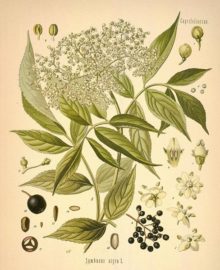 The inner bark is collected from young trees in the autumn and is best sun-dried. It is diuretic, a strong purgative and in large doses emetic. It is used in the treatment of constipation and arthritic conditions. An emollient ointment is made from the green inner bark. The pith of young stems is used in treating burns and scalds. A homeopathic remedy is made from the fresh inner bark of young branches. It relieves asthmatic symptoms and spurious croup in children.
The inner bark is collected from young trees in the autumn and is best sun-dried. It is diuretic, a strong purgative and in large doses emetic. It is used in the treatment of constipation and arthritic conditions. An emollient ointment is made from the green inner bark. The pith of young stems is used in treating burns and scalds. A homeopathic remedy is made from the fresh inner bark of young branches. It relieves asthmatic symptoms and spurious croup in children.
The leaves are used primarily for bruises, sprains, wounds and chilblains. The leaves can be used both fresh or dry. The leaves are purgative, but are more nauseous than the bark. They are also diaphoretic, diuretic, expectorant and haemostatic. The juice is said to be a good treatment for inflamed eyes. An ointment made from the leaves is emollient and is used in the treatment of bruises, sprains, chilblains, wounds etc. It has been reported that Elder Leaves may be useful in an ointment for tumors.
The flowers are the main part used in modern herbalism, Elder flowers are ideal for the treatment of colds and influenza. They are indicated in any catarrhal inflammation of the upper respiratory tract such as hay fever and sinusitis. Catarrhal deafness responds well to Elder Flowers. The fresh flowers are used in the distillation of “Elder Flower Water”. The flowers can be preserved with salt to make them available for distillation later in the season. The water is mildly astringent and a gentle stimulant. It is mainly used as a vehicle for eye and skin lotions.
The dried flowers are diaphoretic, diuretic, expectorant, galactogogue and pectoral. An infusion is very effective in the treatment of chest complaints and is also used to bathe inflamed eyes. The infusion is also a very good spring tonic and blood cleanser. Externally, the flowers are used in poultices to ease pain and abate inflammation. Used as an ointment, it treats chilblains, burns, wounds, scalds etc.
Elder Berries have similar properties to the Flowers, with the addition of their usefulness in rheumatism. The fruit is depurative, weakly diaphoretic and gently laxative. A tea made from the dried berries is said to be a good remedy for colic and diarrhoea. The fruit is widely used for making wines, preserves etc., and these are said to retain the medicinal properties of the fruit.
The root is no longer used in herbal medicine but it formerly had a high reputation as an emetic and purgative that was very effective against dropsy.
Are Elderberries poisonous?
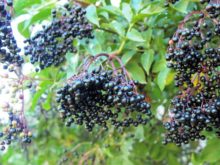 Most species of Sambucus berries are edible when picked ripe and then cooked. Both the skin and pulp can be eaten. However, it is important to note that most uncooked berries and other parts of plants from this genus are poisonous. Sambucus nigra is the variety of Elderberry that is most often used for health benefits as it is the only variety considered to be non-toxic even when not cooked, but it is still recommended to cook the berries at least a little to enhance their taste and digestibility. Continue reading
Most species of Sambucus berries are edible when picked ripe and then cooked. Both the skin and pulp can be eaten. However, it is important to note that most uncooked berries and other parts of plants from this genus are poisonous. Sambucus nigra is the variety of Elderberry that is most often used for health benefits as it is the only variety considered to be non-toxic even when not cooked, but it is still recommended to cook the berries at least a little to enhance their taste and digestibility. Continue reading
Marsh Mallow
- Scientific Name: Althaea officinalis
- Plant Family: Malvaceae
- Parts Used: The whole plant – Leaves, root, flowers.
- Actions (root): Demulcent, Diuretic, Emollient, Vulnerary
- Actions (leaf): Demulcent, Expectorant, Diuretic, Emollient, Anti-Catarrhal, Pectoral
The Basics:
All mallows, including the garden hollyhock, contain quantities of mucilage and the marsh mallow is an especially soothing, healing herb, useful in treating bronchitis, internal inflammation and irritation, for stimulating the kidneys and as a gentle laxative. Tea made from the leaves makes a soothing eye bath.
The high mucilage content of Marsh Mallow makes it an excellent demulcent (relieves inflammation). The root is used primarily for digestive problems, inflammations of the digestive tract and on the skin. The leaf is used for the lungs and the urinary system. For bronchitis, respiratory catarrh and irritating coughs consider Marsh Mallow leaf. It is very soothing in urethritis and urinary gravel. Externally, the root is indicated in varicose veins and ulcers as well as abscesses and boils.
There are many species of mallow growing around the world, often used as food or medicine and possessing similar properties. The young leaves of all the European mallows can be eaten in salads, the older leaves in soups, the roots boiled or fried and the seeds, known as cheeses, chewed fresh. They are all wholesome and their flavor faint and delicate. Continue reading
Yarrow
- Scientific Name: Achillea millefolium
- Plant Family: Compositae
- Parts Used: The whole plant – stems, leaves, flowers, collected in the wild state, in August, when in flower.
- Actions: Diaphoretic, Hypotensive, Astringent, Diuretic, Antiseptic, Anticatarrhal, Emmenagogue, Hepatic, Stimulant, Tonic, Mild Aromatic
The Basics:
Yarrow is a wound herb, astringent and healing, and rich in vitamins and minerals. Bind bruised fresh leaves to cuts, or make an ointment by pounding the flowers and mixing with coconut oil, or bathe wounds with yarrow tea. The tea is also a good tonic drink, it restores lost appetite and promotes perspiration during colds and fevers. Chew fresh leaves to soothe toothache.
Yarrow also lowers blood pressure due to a dilation of the peripheral vessels. It stimulates the digestion and tones the blood vessels. As a urinary antiseptic it is indicated in infections such as cystitis. It is considered to be a specific in thrombotic conditions associated with high blood pressure.
The flowers are often steamed and inhaled to treat hay fever and asthma and in teas for respiratory problems, as a wash for eczema and other skin conditions; and in chest rubs for cold, flu, and inflamed joints. Continue reading
Rennie Luttrull: queen-annes-lace-seeds
Rosanna: Spignel aka Bald Money
Annamarie Squatrito: Fumitory
EILEEN Klinghagen: Pumpkin
Mahmudul Hasan: Celery
